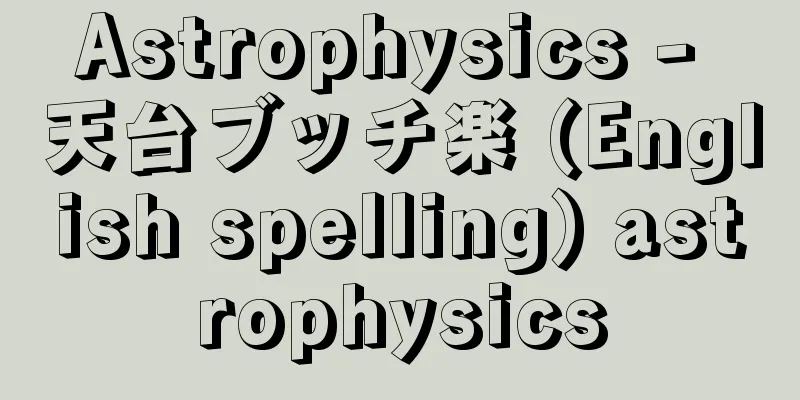Champagne - Champagne (English spelling) French

|
Sparkling wine made in the Champagne region of France. Sparkling wine made outside of the Champagne region cannot be called champagne. In other regions of France, it is called vin mousseux, Sekt in Germany, spumante in Italy, and cava in Spain. In Japan, it is also called champagne. [Hara Masamichi] historyChampagne is said to have been discovered by Dom Pérignon, who was the cellar attendant at the Hobje Monastery in the Champagne region towards the end of the 17th century. One year, he bottled wine that was still fermenting and sealed it tightly with a cork. When he opened it the following year, the carbon dioxide had been mixed into the wine, giving it an indescribably delicious taste. This was in 1694, and it is said that what was passed down as a secret technique from the monastery later spread throughout the region. [Hara Masamichi] Manufacturing methodThe grapes for champagne are Pinot Noir and Pinot Meunier for red, and Chardonnay for white. After fermentation, the wine is blended to equalize the quality and bottled. The wine in the bottle is sugared to about 2.5% and champagne yeast is added for re-fermentation. The bottle is sealed with a cork and tied with wire. When fermentation is complete, the yeast settles to the bottom, so the bottle is turned upside down and tilted 45 degrees to allow the yeast to settle to the mouth of the bottle. Next, the neck of the bottle is placed in a tank cooled to -25°C, and the inside is frozen. When the cork is removed, the ice cubes fly out due to the pressure inside. Next, wine containing sugar and brandy is quickly added to the empty space, and the taste is adjusted before the cork is sealed and the bottle is stored. The above-mentioned bottle fermentation is the standard imposed on champagne. [Hara Masamichi] kindsChampagne is often a slightly brownish yellow color, but there is also rosé. It contains carbon dioxide, the pressure inside the bottle is 4-6 atmospheres at 10 degrees Celsius, and the alcohol content is about 13%. There are sweet and dry varieties. They are distinguished by the following: the driest is called brut, the very dry is called extra sec, the dry is called sec, the slightly sweet is called demi sec, and the sweet is called deux. However, even sec in champagne contains 3-4% sugar, so it tastes sweet. Of the expensive champagnes, Dom Pérignon (produced by Moet & Chandon), named after the person who discovered champagne, is particularly famous. [Hara Masamichi] "The Complete Book of Champagne" by Tatsuyuki Tanaka (1994, Hakubokusha) " "The Story of Champagne" by Hiroshi Yamamoto (1992, Shibata Shoten) [Reference] | |Source: Shogakukan Encyclopedia Nipponica About Encyclopedia Nipponica Information | Legend |
|
フランスのシャンパーニュ地方でできる発泡性のワイン。シャンパーニュ地方以外でつくられた発泡性ワインをシャンパンとよぶことは禁止されている。同じフランスでも他の地域の酒はバン・ムスーvin mousseux、またドイツではゼクトSekt、イタリアではスプマンテspumante、スペインではカバcavaとよばれる。日本ではシャンペンともいう。 [原 昌道] 歴史シャンパンは17世紀の終わりごろ、シャンパーニュ地方のホービェー僧院の酒倉係をしていたドン・ペリニョンの発見といわれる。ある年、発酵がまだ残っているワインを瓶に詰めて、コルク栓でしっかり栓をしておいたところ、翌年あけてみると炭酸ガスが酒に含まれて、なんともいえぬよい味になっていた。これが1694年のことで、この寺の秘法として伝わったものが、のちにこの地方に広がったといわれる。 [原 昌道] 製法シャンパン用のブドウは赤のピノ・ノワール種とピノ・ムニエ種、白のシャルドネ種である。発酵終了後ブレンドして品質の均一化を行い、瓶に詰める。瓶内の酒には糖分が2.5%ぐらいになるように補糖し、シャンパン酵母を加えて再発酵させる。瓶はコルクで密栓し、針金で縛る。発酵が終わると酵母が下に沈殿してくるから、瓶を逆さにして、45度に傾けて酵母を瓶口に沈降させる。次に瓶の口元だけを零下25℃に冷却した槽につけ、内部を凍らせたのち栓を抜くと、中の圧力で氷の塊のおりが外へ飛び出す。次に空いた部分にすばやく砂糖やブランデーの入ったワインを入れ、味の調節を行ったのちコルク栓をし、針金で縛って貯蔵する。以上述べた瓶内発酵は、シャンパンに課せられた規格である。 [原 昌道] 種類シャンパンはやや褐色がかった黄色のものが多いが、ロゼもある。炭酸ガスを含んでおり、瓶内圧力は10℃で4~6気圧、アルコールは13%程度である。甘口と辛口がある。もっとも辛口をブリュット、かなり辛口をエクストラ・セック、辛口をセック、やや甘口をドゥミ・セック、甘口をドゥとよんで区別する。ただしシャンパンでは、セックでも糖分は3~4%含まれており、甘く感じる。高価なシャンパンのなかでも、シャンパンの発見者の名前を冠したドン・ペリニョン(モエ・シャンドン社で製造)はとくに有名である。 [原 昌道] 『田中辰幸著『シャンパン全書』(1994・白墨舎)』▽『山本博著『シャンパン物語』(1992・柴田書店)』 [参照項目] | |出典 小学館 日本大百科全書(ニッポニカ)日本大百科全書(ニッポニカ)について 情報 | 凡例 |
Recommend
Sea cave - kaishokudo
A cave carved into a sea cliff by the erosive act...
Elea School - Elea School
A school of philosophy that arose in the 5th cent...
Nazarene - Nazarene
[1] 〘Noun〙① The name used by non-Jews to refer to ...
X Window
...Human interface (HI) is, in a broad sense, the...
Khorana, HG (English spelling) KhoranaHG
…He discovered that adding polyuridylic acid (a p...
Salamis
…the historic naval battle of 480 BC in the Secon...
Arao River
A river that flows through northwest Miyagi Prefe...
Electroluminescence
Light emission other than that caused by heat is ...
Sunthonphu (English spelling)
1785‐1855 Thailand's greatest poet. Sunthongpu...
Terramare culture
A Middle to Late Bronze Age culture that flourishe...
Modern land ownership
…Land ownership is one way in which humans are co...
Tomb of Princess Yongtai
One of the Qianling's associated tombs in Qia...
Ilonggo
...based on linguistic classification, the Cebuan...
Film Law - Eigahou
This law was enacted with the aim of achieving tot...
Oceanodromous fish
…Ayu are called amphidromous fish because they ar...









